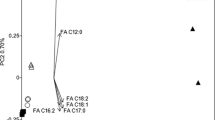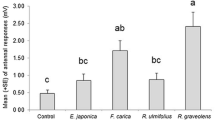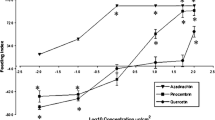Abstract
Extracts of whole booklice (Liposcelis bostrychophila)—sequentially extracted in hexane and aqueous 80% methanol (80%MeOH)—repel conspecifics. A methanol-soluble fraction (MFr) of the 80% methanol extract was more repellent than either its corresponding water fraction (WFr) or the hexane extract. The repellent effect of the MFr was repeatable across extracts prepared on different occasions over a 1 month period. Gas chromatography, mass-spectrometry (GC-MS) analyses showed that saturated (C16; C18) monoenoic (C16:1; C18:1) and a dienoic fatty acid (C18:2) and the corresponding methyl esters of all but C16:1 and C18 constituted approximately 95% and 30%, of the detected compounds in the methanol fractions and the hexane extract, respectively. Qualitative thin layer chromatography showed that cholesterol was present in methanol fractions and the hexane extract, and also enabled tentative identification of triacylglycerols and phospholipids in the methanol fractions. Extracts of wheatgerm, dried skimmed milk powder, active yeast, and wholemeal flour—L. bostrychophila dietary components—were analyzed by GC-MS, and C16, C18:1 and C18:2 were detected, indicating that C18 and the methyl esters were not directly extractable and/or that they were products of booklice metabolism. A fatty acid amide (stearamide) previously identified in cuticular extracts of L. bostrychophila was not detected, and therefore was not responsible for the observed biological activity. Pure fatty acids and fatty acid methyl esters repelled settling of L. bostrychophila at 10 mM, with the exception of palmitic and stearic acids, indicating, among other things, a difference between the efficacy of saturated and unsaturated fatty acids. The effect of concentrations <10 mM was less significant, although palmiteoleic acid appeared to be attractive to L. bostrychophila at 0.1 mM. Fatty acids and fatty acid methyl esters were at a much lower concentration than 10 mM in the repellent methanol fractions, indicating that an interaction between known and as yet unidentified compounds is likely. The significance of fatty acids in relation to the biology and behavior of L. bostrychophila and their potential for use in traps and monitoring are discussed.




Similar content being viewed by others
References
Ausloos, P., Clifton, C., Lias, S. G., Shamim, A., and Stein, S. 1992. NIST/EPA/NIH Mass Spectral Database (v. 4.0). US Department of Commerce, Gaitherburg, USA.
Badonnel, A. 1931. Contribution a l’étude de la faune du Mozambique. Voyage de M.P.Lesne (1928–1929). 4e note. Copéognathes. Ann. Sci. Nat. Zool. 14: 229–260.
Baer, B., Morgan, E. D., and Schmid-Hempel, P. 2000. A nonspecific fatty acid within the bumblebee mating plug prevents females from remating. Proc. Natl. Acad. Sci. U.S.A. 98: 3926–3928.
Bashan, M., Akbas, H., and Yurdakoc, K. 2002. Phospholipid and triacylglycerol fatty acid composition of major life stages of sunn pest, Eurygaster integriceps (Heteroptera: Scutelleridae). Comp. Biochem. Phys. B. 132: 375–380.
Bernklau, E. J. and Bjostad, L. B. 2008. Identification of feeding stimulants in corn roots for western corn rootworm (Coleoptera: Chrysomelidae) larvae. J. Econ. Entomol. 101: 341–351.
Bird, T. G., Hedin, P. A., and Burks, M. L. 1987. Feeding deterrent compounds to the boll weevil, Anthonomus grandis Boheman in Rose-of-Sharon, Hibiscus syriacus L. J. Chem. Ecol. 13: 1087–1097.
Buckner, J. S. and Hagen M. M. 2003. Triacylglycerol and phospholipid fatty acids of the silverleaf whitefly: composition and biosynthesis. Arch. Insect Biochem. Physiol. 53: 66–79.
Cakmak, O., Bashan, M., and Bolu, H. 2007. The fatty acid compositions of predator, Piocoris luridus (Heteroptera: Lygaeidae) and its host Monosteria unicostata (Heteroptera: Tingidae) reared on almond. Insect Sci. 14: 461–466.
Chamberlain, P. M. and Black, H. I. J. 2005. Fatty acid compositions of Collembola: unusually high proportions of C-20 polyunsaturated fatty acids in a terrestrial invertebrate. Comp. Biochem. Phys. B. 140: 299–307.
Cook, S. M., Khan, Z. R., and Pickett, J. A. 2007. The use of push-pull strategies in integrated pest management. Annu. Rev. Entomol. 52: 375–400.
Dani, F. R., Cannoni, S., Turillazzi S., and Morgan E. D. 1996. Ant repellent effect of the sternal gland secretion of Polistes dominulus (Christ) and P-sulcifer (Zimmermann) (Hymenoptera: Vespidae). J. Chem. Ecol. 22: 37–48.
Gabel, B. and Thiéry, D. 1996. Oviposition response of Lobesia botrana females to long-chain free fatty acids and esters from its eggs. J. Chem. Ecol. 22: 161–171.
Gołębiowski, M., Maliński, E., Nawrot, J., Szafranek, J., and Stepnowski, P. 2007. Identification of cuticular lipid concentration of the western flower thrips Frankliniella occidentalis. Comp. Biochem. Phys. B. 147: 288–292.
Gołębiowski, M., Maliński, E., Boguś, M. I., Kumirska, J., and Stepnowski, P. 2008a. The cuticular fatty acids of Calliphora vicina, Dendrolimus pini and Galleria mellonella larvae and their role in resistance to fungal infection. Insect Biochem. Molec. 38: 619–627.
Gołębiowski, M., Maliński, E., Nawrot, J., and Stepnowski, P. 2008b. Identification and characterisation of surface lipid composition of the dried bean beetle Acanthoscelides obtectus (Say) (Coleoptera: Bruchidae). J. Stored Prod. Res. 44: 386–388.
Green, P. W. C. 2005. Substrate selection by Liposcelis bostrychophila Badonnel (Psocoptera: Liposcelididae): effects of insect extracts and biodeteriorated book-paper. J. Stored Prod. Res. 41: 445–454.
Green, P. W. C. 2008. Fungal isolates involved in biodeterioration of book- and their effects on substrate selection by Liposcelis bostrychophila (Badonnel) (Psocoptera: Liposcelididae). J. Stored Prod. Res. 44: 258–263.
Green, P. W. C. and Turner B. D. 2005. Food-selection by the booklouse, Liposcelis bostrychophila Badonnel (Psocoptera: Liposcelididae). J. Stored Prod. Res. 41: 103–113.
Henderson, G., Wells, J. D., and Jeanne, R. L. 1991. Methyl palmitate and methyl myristate repel flies. Fla. Entomol. 74: 365–368.
Herman, T., Miloslavski, I., Aizenshtat, Z., and Applebaum, S. W. 2005. presence and titer of methyl palmitate in medfly (Ceratitis capitata) during reproductive maturation. J. Insect Physiol. 51: 473–479.
Hibbard, B. E., Bernklau, E. J., and Bjostad, L. B. 1994. Long-chain free fatty acids: semiochemicals for host location by western corn rootworm larvae. J. Chem. Ecol. 20: 3335–3344.
Horikoshi, M., Takabayashi, J., Yano, S., Yamaoka, R., Ohsaki, N., and Sato, Y. 1997. Cotesia glomerata female wasps use fatty acids from plant-herbivore complex in host searching. J. Chem. Ecol. 23: 1505–1515.
Howard, R. W. and Lord, J. C. 2003. Cuticular lipids of the booklouse, Liposcelis bostrychophila: hydrocarbons, aldehydes, fatty acids and fatty acid amides. J. Chem. Ecol. 29: 615–627.
Howard, R. W. and Blomquist, G. J. 2005. Ecological, behavioural and biochemical aspects of insect hydrocarbons. Annu. Rev. Entomol. 50: 371–393.
Howard, D. F., Blum, M. S., Jones, T. H., and Phillips, D. W. 1982. Defensive adaptations of eggs and adults of Gastrophysa cyanae (Coleoptera: Chrysomelidae). J. Chem. Ecol. 8: 453–462.
Hwang, Y-S., Schultz, G. W., and Mulla, M. S. 1984. Structure-activity relationship of unsaturated fatty acids as mosquito ovipositional repellents. J. Chem. Ecol. 10: 145–151.
Jarrold, S. L., Moore, D., Potter, U., and Charnley, A. K. 2007. The contribution of surface waxes to pre-penetration growth of an entomopathogenic fungus on host cuticle. Mycol. Res. 111: 240-249.
Juárez, M. P. and Fernandez, G. C. 2007. Cuticular hydrocarbons of triatomines. Comp. Biochem. Phys. A. 147: 711–730.
Kaib, M., Franke, S., Francke, W., and Brandl, R. 2002. Cuticular hydrocarbons in a termite: phenotypes and a neighbour-stranger effect. Physiol. Entomol. 27: 189–198.
Kupke, I.R. and Zeugner, S. 1978. Quantitative high-performance thin-layer chromatography of lipids in plasma and liver homogenates after direct application of 0.5-µl samples to the silica-gel layer. J. Chromatogr. 146: 261–271.
Legal, L., Moulin, B., and Jallon, J. M. 1999. The relation between structures and toxicity of oxygenated aliphatic compounds homologous to the insecticide octanoic acid and the chemotaxis of two species of Drosophila. Pestic. Biochem. Physiol. 65: 90–101.
Li, G. and Ishikawa, Y. 2006. Leaf epicuticular wax chemicals of the Japanese knotweed Fallopia japonica as oviposition stimulants for Ostrinia latipennis. J. Chem. Ecol. 32: 595–604.
Lord, J. C. and Howard, R. W. 2004. A proposed role for cuticular fatty amides of Liposcelis bostrychophila (Psocoptera: Liposcelidae) in preventing adhesion of entomopathogenic fungi with dry conidia. Mycopathologia 158: 211–217.
Lucas, C., Pho, D. B., Jallon, J. M., and Fresneau, D. 2005. Role of cuticular hydrocarbons in the chemical recognition between ant species in the Pachycondyla villosa species complex. J. Insect Physiol. 51: 1148–1157.
Miller, J. R. and Cowles, R. S. 1990. Stimulo-deterrent diversion: a concept and its possible application to onion maggot control. J. Chem. Ecol. 16: 3197–3212.
Moshitzky, P., Miloslavski, I., Aizenshtat, Z., and Applebaum, S. W. 2003. Methyl palmitate: a novel product of the medfly (Ceratitis capitata) corpus allatum. Insect Biochem. Mol. Biol. 33: 1299–1306.
Nelson, D. N. and Charlet, L. D. 2003. Cuticular hydrocarbons of the sunflower beetle, Zygogramma exclamationis. Comp. Biochem. Physiol. B. 135: 273–284.
New, T. R. 2005. Psocids, Psocoptera (Booklice and Barklice). Handbooks for the Identification of British Insects 1(7). Royal Entomological Society, London.
Nilsson, E. and Bengtsson, G. 2004. Endogenous free fatty acids repel and attract Collembola. J. Chem. Ecol. 30: 1431–1443.
Parr, M. J., Tran, B. M. D, Simmonds, M. S. J., Kite, G. C., and Credland, P. F. 1998. Influence of some fatty acids on oviposition by the bruchid beetle, Collosobruchus maculatus. J. Chem. Ecol. 24: 1577–1593.
Prouvost, O., Trabalon, M., Papke, M., and Schulz, S. 1999. Contact sex signals on web and cuticle of Tegenaria atrica (Araneae: Agelenidae). Arch. Insect Biochem. Physiol. 40: 194–202.
Reinhard, J., Quintana, A., Streng, L., and Clement, J. L. 2003. Chemical signals inducing attraction and alarm in European Reticulotermes termites (Isoptera, Rhinotermitidae). Sociobiology 42: 675–691.
Retief, E., Nicholas, A., and Baijnath, H. 1995. The psocid, Liposcelis bostrychophilus Badonnel (Psocoptera: Liposcelididae)—an occasional herbarium pest. Bothalia 25: 247–253.
Roux, O., Gers, C. and Legal, L. 2006. When, during ontogeny, waxes in the blowfly (Calliphoridae) cuticle can act as phylogenetic markers. Biochem. Syst. Ecol. 34: 406–416.
Scott, M. P., Madjid, K., and Orians, C. M. 2008. Breeding alters cuticular hydrocarbons and mediates partner recognition by burying beetles. Anim. Behav. 76: 507–513.
Singh, K., Rangaswamy, J. R., and Majumder, S. K. 1985. Olfactory behavior of red flour beetle Tribolium castaneum (Herbst) (Coleoptera, Tenebrionidae) towards natural fatty acid esters. J. Chem. Ecol. 11: 495–500.
Stahl, P. D. and Klug, M. J. 1996. Characterization and differentiation of filamentous fungi based upon fatty acid composition. Appl. Environ. Microbiol. 62: 4136–4146.
Stanley-Samuelson, D.W., Jurenka, R. A., Crips, C., Blomquist, G. J., and de Renobales, M. 1988. Fatty acids in insects: composition, metabolism, and biological significance. Arch. Insect Biochem. Physiol. 9: 1–33.
Thiéry, D., Gabel, B., Farkas, P., and Jarry, M. 1995. Egg dispersion in codling moth: influence of egg extract and of its fatty acid constituents. J. Chem. Ecol. 21: 2015–2026.
Trouiller, J., Arnold, G., Chappe, B., Le Conte, Y., and Masson, C. 1992. Semiochemical basis of infestation of honey bee brood by Varroa jacobsoni. J. Chem. Ecol. 18: 2041–2053.
Turner, B. D. 1987. Forming a clearer view of Liposcelis bostrychophilus. Environ. Health. 95: 9–13.
Turner, B. D. 1994. Liposcelis bostrychophila (Psocoptera: Liposcelididae), a stored food pest in the UK. Int. J. Pest Manage. 40: 179–190.
Turner, B. D. and Maude-Roxby, H. 1988. Starvation survival of the stored product pest Liposcelis bostrychophilus Badonnel (Psocoptera: Liposcelidae). J. Stored Prod. Res. 24: 23–28.
Turner, B. D. and Maude-Roxby, H. 1989. The prevalence of the booklouse Liposcelis bostrychophilus Badonnel (Liposcelidae: Psocoptera) in British domestic kitchens. Int. Pest Control 31: 93–97.
Acknowledgements
Dr’s. M.-J. Howes and G. Kite are thanked for their advice and technical assistance with the mass spectrometer. I am grateful to Mr. Dudley Farman for running GC-MS analyses of some samples at NRI (University of Greenwich). Dr. P. Stevenson and Professor M. Simmonds are thanked for their comments on a previous version of this manuscript. Anonymous reviewers are thanked for their very helpful suggestions, which significantly improved the manuscript.
Author information
Authors and Affiliations
Corresponding author
Rights and permissions
About this article
Cite this article
Green, P.W.C. The Effects of Insect Extracts and Some Insect-Derived Compounds on the Settling Behavior of Liposcelis bostrychophila . J Chem Ecol 35, 1096–1107 (2009). https://doi.org/10.1007/s10886-009-9688-3
Received:
Revised:
Accepted:
Published:
Issue Date:
DOI: https://doi.org/10.1007/s10886-009-9688-3




